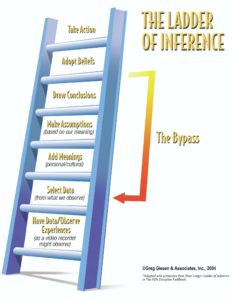Conflict Management Rule 2: Stay Off the Ladder

Have you ever been cut-off by a driver on the highway and then instantly gave them some feedback?
Have you ever said something to someone that you didn’t mean?
Have you ever misjudged someone only to find out later that you were wrong?
If you answered “yes” to any of the above questions, congratulations! You may not know it but you have already climbed the Ladder of Inference.
The Ladder of Inference comes from Peter Senge’s book, The Fifth Discipline Fieldbook, where Senge uses the ladder as a metaphor to talk about how we create beliefs based on limited assumptions. Allow me to explain using my tweaked version of Senge’s model (created with permission).
Let’s take the example of giving some instant feedback to the guy who just cut you off on the highway…
Here’s essentially what you did, starting from the bottom of the ladder and moving up:
- While driving, you focused on a specific incident at a specific moment (What are you doing!)
- You made a quick assumption about the other driver (You idiot!)
- You drew a conclusion based on your assumption (Why don’t you go back to Driver’s Ed and learn to drive!)
- You formed a belief about the driver (Ah, out of town plates…that explains it!)
- And, if that wasn’t enough, you took an action (Take that! as you waved your fist at the driver while passing him)
 In the above example, you went from the bottom of the ladder to the top in less than two seconds.
In the above example, you went from the bottom of the ladder to the top in less than two seconds.
See the problem?
The quicker we go up the ladder (from assumptions to action), the less control we have over outcomes. Let’s break this down…
The problem with racing up the ladder towards action is:
- The more emotion we have, the faster we climb the ladder. The faster we climb the ladder, the less control we have on the outcome. The less control we have on the outcome, the more out-of-hand the conflict can get.
- We do not live in a stimulus—response world. Nobody makes us feel a certain way. Nobody causes us to respond in a particular manner. Nobody is responsible for our actions but us. When we immediately respond to a stimulus (i.e., being cut off on the road), we have removed the thought-process from the situation and allowed our emotions to take over. This leads to a stimulus—response mindset where we get to blame somebody or something for our response. Not good.
In truth there’s actually a three steps process that takes place, not two: There is Step 1) an activating event (stimulus); Step 2) our assessment of the activating event (going up or down the ladder), and Step 3) our response. In other words, Step 1 did not cause Step 3…Step 2 caused Step 3; and Step 2 is about us not about them!
The good news here is that when we are mindful of our movement up the ladder, we get to stop the process before any action is taken. We get to regain control in the moment and choose to respond from a logical place. Or to put it another way, we get to begin the process of climbing down the ladder.
- There is also an important missing piece when we go up the ladder. Do you know what it is?
It’s the other side of the story. It’s understanding why someone did what they did. It’s getting all the information before choosing a response.
You see, the Ladder of Inference is a one-sided process. It allows us to play judge and jury over someone else’s actions and make a conviction without ever hearing their side. The obvious upside is that we get to be right. The unfortunate downside is that it’s not a fair process. It’s not fair to the other party nor is it fair to us.
The key here is to:
- Turn a primarily unconscious process into a conscious process.
- Not respond to an activating event without first having all the facts.
- Catch ourselves going up the ladder and coach ourselves back down the ladder.
- Slow down all stimulus-response behavior patterns where we currently have little to no control over how we respond to a particular triggering event. By simply not responding automatically, we introduce thought into the process.
- Always give the benefit of doubt in situations or with people where we do not have all the information on what’s going on. After all, wouldn’t you want someone else to give you the same respect?
A buddy of mine who is “Ladder of Inference-savvy” came up to me and said, “You said something yesterday that confused me and I found myself going up the ladder about what I think you meant. Instead of doing that, I wanted to just come out and ask you directly.”
When I heard my buddy Tim say that to me, I respected him even more than I already did. He not only took responsibility for his interpretation of what I said but he stopped short of taking any kind of action without first speaking to me to get more clarification.
Question: Guess what the majority of issues are that I mediate between employees?
Misperceptions. That’s right, misperceptions of a past action or behavior that slowly turned into an assumption, conclusion, belief, and action. I literally have to break down a past situation with the conflicting parties so that both perspectives are shared with each other; then and only then can resolution take place.
Guess where gossip fits into the Ladder of Inference?
It’s what I call a secondhand ladder. One person climbs the ladder about someone or something and ends up sharing their perception with another and then another. Before long everyone has a version of the story but no one has the whole story.
Lastly, there’s the Bypass on the Ladder of Inference. The Bypass essentially means that our beliefs about someone or something are so strong that any new data to the contrary will be disregarded in order to preserve our current beliefs.
A couple that my ex-wife and I used to invite over had a tendency to cancel at the last minute on a fairly frequent basis. In fact, it happened so regularly that we had a bypass going on. Sure enough, the night before we were supposed to get together again the phone rang and the Caller-ID showed it was from them. Upon seeing their name, I gave my wife a knowing glance and proceeded to shake my head in disappointment as I answered the call.
“Hello.”
Greg, this is Ray.”
“Ray, how nice to hear from you,” I said sarcastically, knowing what was coming next.
“Bad news…we are not going to be able to make it over tomorrow.”
Looking over at my ex-wife I point to the phone to indicate that they’re doing it again.
“Oh, that’s terrible. Is everything okay?” I asked, not really interested in hearing yet another excuse.
“Jenny’s parents are coming into town tomorrow.”
And you schedule this knowing we were supposed to get together, I thought. “Okay, we’ll maybe next time,” knowing that there wouldn’t be a next time.
A couple days later I found out the rest of the story…Jen had been diagnosed with stage 4 cancer. Her parents were coming into town to be with her.
We felt terrible. We were so certain (the Bypass) that we were right about our friends that we didn’t leave any room for other options.
The Bypass prevents relationships or situation from being different. The Bypass prevents change. The Bypass is a blockage of sorts, much like a clogged artery.
If you have a bypass and it is with a person that matters to you, then break it down and change the relationship. Bypasses protect us but they do nothing for the betterment of a relationship or a situation. We essentially become frozen in time.
There are people out there right now that have bypasses with us and we don’t even know it. Likewise, we have bypasses with other people and they don’t know it either.
I don’t know about you but I’d rather that the people in my life not have bypasses with me. I want to believe that I can change and that I value every relationship I have. Don’t you?
So that’s Rule-2 in a nutshell: Stay Off the Ladder. So stay off the ladder!
Stay tuned for Rule 3 next week!
-Geese
______________________________________________
Greg Giesen is a professional speaker, management coach, facilitator of the award winning program, Leading From Within, radio talk show producer / host, and author of, Mondays At 3: A Story for Managers Learning to Lead. Go to www.GregGiesen.com for more information.
Category: Leadership
Tags: Accountability, Assumptions, Coaching, Conflict, Conflict Management, conflict resolution, Greg Giesen, Negotiation, team building






An excellent article when encouraged with the attitude of “positive intent” an excellent visual for staff leadership to remember the concept. Thank you!